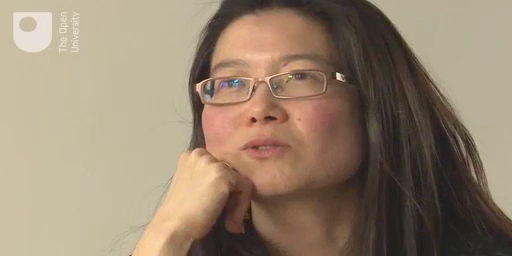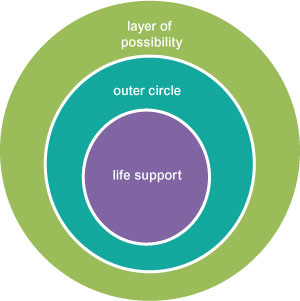3 Networking
In this section you’ll be looking at how to start brushing up, building and tapping into your networks. If you spend a little time thinking about who you know, you can probably find people who can help you in a variety of ways.
The word ‘networking’ elicits a range of responses. Some see it as self-promotion – a sort of pressurised, egotistical form of personal marketing where you push yourself forward ruthlessly to get noticed.
Perhaps a more useful definition of networking is that which is used by businesses. Networking is ‘the building and nurturing of personal and professional relationships to create a system or chain of information, contacts and support’ (De Janasz et al., 2009, p. 328). This definition highlights the benefits of belonging to networks. They provide the three key ingredients that a returner needs when looking for a job or re-establishing a career – ‘information, contacts and support’.
Returners often say that they don’t have any networks and it is true that it can be hard to keep your professional networks alive when you are out of work for a period of time, but with a little bit of thought, you can discover that you already have a personal and professional network – even if you don’t recognise it as such. It’s not necessary to strictly separate out the personal and professional elements of your network. Regardless of how or why you know people, each person you know is a potentially useful contact and the reason you know them is normally because you have some shared goal, interest or experience.
Listen to Azu talk about how her STEM ambassador volunteering work helped her build her networks and helped her return to work.

Transcript
Activity 3 Mapping out your network
When thinking about building or maintaining your networks, it is sometimes a good idea to start by mapping out where you stand currently. So think – who do you know? It may help to use the following simple framework.

1. First, there are the people immediately around you with whom you speak or liaise on a daily or weekly basis. This is the central core of your network, your inner circle – your life support. Most (though not all) of the people here will be family members, geographically close to you, or connected to you through marriage, other partnerships or long standing friendships. Many of them will be ‘need-to-know’ people with whom you simply must get on and who have a direct impact on the smooth running of your life, your work and your emotional wellbeing. Many of them will be as dependent on you as you are on them.
2. The next layer – your outer circle – is just slightly more distant but potentially also vital to your success and happiness. This layer includes the wider network of people around you with whom you share experiences, such as wider family and more distant friends, parents of your children’s friends, your neighbours, your partner’s colleagues and a range of contacts from your previous employment. This circle includes people who could help you to solve a particular problem.
3. Then there is your outer circle – your layer of possibility. This layer is full of people with whom you either share interests or have something in common with and to whom you could, potentially, be properly connected. Sometimes you don’t know these people at all, or you don’t know them very well. Importantly, this layer also contains people who might benefit from getting in touch with you; people who are interested in your skills and knowledge, who are recruiting or who are keen to make referrals to others who are recruiting. This layer is full of potential and possible openings. In order to tap into it and benefit from it you need to think about your profile. Who knows you and what you do? How do they know you? What can they find out about you? How easy are you to find?
Download the Network map template [Tip: hold Ctrl and click a link to open it in a new tab. (Hide tip)] and write the names of people in your network in the different circles.
Discussion
In terms of actions to protect, maintain and develop your networks, consider the following:
- The people in your life support circle are vital to everyday home and working life. These relationships are very important and should be a priority. Beware of stress, or pressures on your time that cause you to neglect relationships in this circle. Maintaining good relationships with your main support circle is linked with good time management, sensible prioritising and regular communication.
- Your outer circle is full of people who can add value to your life, either because they can help you to do the things you need to do, or because you can help them to do things that benefit you both. This circle will include a range of people; for example, you may have met them while working, or because of shared hobbies or interests, or through volunteer organisations such as the Parents Association at your children’s school. Contacts in this layer can be great facilitators, so mapping this layer can be useful because it can contain a variety of people who are in a position to help you in different ways:
- Do you know any former work colleagues who could update you on developments in your industry sector? Could they act as a referee, or review your CV? Do they know of any openings or opportunities, or could they help with a short work placement or shadowing opportunity to help rebuild your knowledge, skills or confidence? If yes, why not drop them an email saying you would love their advice and ask if you could speak by phone or, better still, if you could buy them a coffee and have a quick chat?
- Are you making the most of the networking opportunities that are around you every day? Are you attending events or conferences that would update your knowledge and help you meet people? Are you looking out for relevant training programmes to refresh your skills? Are you meeting new people through volunteering? Are there online groups that you could join? When opportunities come along, be brave and step forward!
- To develop your layer of possibility, you need to be thinking widely, expanding your horizons and thinking about your visibility and your online profile. Some suggestions for developing your layer of possibility are joining a professional body, attending lectures or networking events in your region, or looking for online communities to join, following others online, and reading newsletters and blogs.
